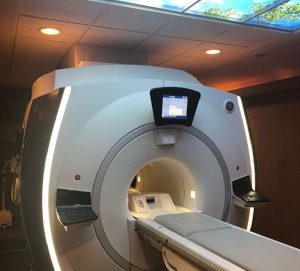What is it?
Magnetic resonance imaging (MRI) is a technique that uses a magnetic field and radio waves to create detailed images of the organs and tissues within your body. Most MRI machines are large, tube-shaped magnets. When you lie inside an MRI machine, the magnetic field temporarily realigns hydrogen atoms in your body. Radio waves cause these aligned atoms to produce very faint signals, which are used to create cross-sectional MRI images — like slices in a loaf of bread. The MRI machine can also be used to produce 3-D images that may be viewed from many different angles.
Why an MRI is performed:
MRI is a noninvasive way for your physician to examine your organs, tissues and skeletal system. It produces high-resolution images that help diagnose a variety of problems.
Are there risks?
The presence of metal in your body may be a safety hazard or affect a portion of the MRI image. Before receiving an MRI, tell the technologist if you have any metal or electronic devices in your body, such as:
- Metallic joint prostheses
- Artificial heart valves
- An implantable heart defibrillator
- A pacemaker
- Metal clips, pins, screws, plates tents or surgical staples
- Cochlear implants
- A bullet, shrapnel or any other type of metal fragment
- Intrauterine device
You may be required to get an eye exam before getting an MRI.
Before you schedule an MRI, tell your doctor if you think you’re pregnant. The effects of magnetic fields on fetuses aren’t well understood. Your doctor may recommend choosing an alternative exam or postponing the MRI.
It’s also important to discuss any kidney or liver problems with your doctor and the technologist, because problems with these organs may limit the use of injected contrast agents during your scan.

Spring Valley Diagnostic Imaging Department:
Facility hours may vary. Please call to schedule an appointment. Saturday morning appointments are sometimes available for busy schedules.
Call (815) 664-1365
Peru Diagnostic Imaging Department:
Facility hours may vary. Please call to schedule an appointment. Evening appointments as late as 7:30pm are available on some days.
Call (815) 780-3280
How to prepare:
Before an MRI exam, eat normally and continue to take your usual medications, unless otherwise instructed. You will be asked to change into a gown and to remove:
- Jewelry
- Hairpins
- Eyeglasses
- Watches
- Wigs
- Dentures
- Hearing Aids
- Underwire bras
- Cosmetics that contain metal particles
What to expect during the test:
The MRI machine looks like a tube that has both ends open. You lie down on a movable table that slides into the opening of the tube. A technologist monitors you from another room and can communicate with you by microphone. The MRI machine creates a strong magnetic field around you, and radio waves are directed at your body. The procedure is painless, and you don’t feel the magnetic field or radio waves. There are also no moving parts around you.
During the MRI scan, the internal part of the magnet produces repetitive tapping, thumping and other noises. Earplugs or music may be provided to help block the noise. If you are worried about feeling claustrophobic inside the MRI machine, talk to your doctor beforehand. You may receive a sedative before the scan.
In some cases, a contrast material, typically gadolinium, may be injected through an intravenous (IV) line into a vein in your hand or arm. The contrast material enhances the appearance of certain details. The material used for MRIs is less likely to cause an allergic reaction than the material used for CT scans.
An MRI can last up to an hour or more. You must hold very still because movement can blur the resulting images.
What to expect after the test:
If you haven’t been sedated, you may resume your usual activities immediately after the scan.
Results:
A doctor specially trained to interpret MRIs (radiologist) will analyze the images from your scan and report the findings to your doctor. Your doctor will discuss any important findings and next steps with you.

Our MRI high field magnet offers both excellent quality images and a user-friendly experience. Patients are more comfortable during the scan due to its larger opening.
Evening and Saturday Availability for Busy Schedules
We know that life is busy and some schedules don’t allow for daytime appointments or appointments during the week. That’s why at St. Margaret’s we try our best to offer convenient MRI hours when possible. At our Peru Diagnostic Imaging Department, we offer evening appointments as late as 7:30 PM on some days (appointment required). The latest appointment time currently available at Spring Valley is 4pm. At our Spring Valley location, we also offer Saturday morning appointments. Peru does not currently offer any Saturday availability. Remember, hours may differ between these two facilities and normal schedules at each location may vary at times as well.
